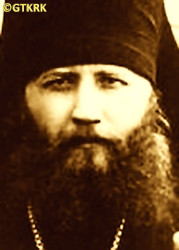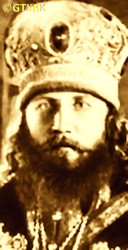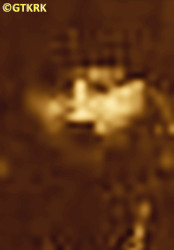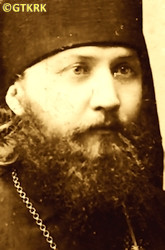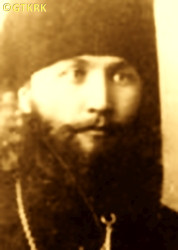Roman Catholic
St Sigismund parish
05-507 Słomczyn
85 Wiślana Str.
Konstancin deanery
Warsaw archdiocese, Poland
full list:
displayClick to display full list

searchClick to search full list by categories
wyświetlKliknij by wyświetlić pełną listę po polsku

szukajKliknij by przeszukać listę wg kategorii po polsku

Martyrology of the clergy — Poland
XX century (1914 – 1989)
personal data
religious status
saint
surname
KIEDROW
forename(s)
Polycarp (pl. Polikarp)
religious forename(s)
Abercius (pl. Abercjusz)

canonisation date
01.11.1981

Russian Orthodox Church Outside of Russia
function
archbishop
creed
Eastern Orthodox Church ORmore on
en.wikipedia.org
[access: 2014.09.21]
diocese / province
Volyn‐Zhytomyr OR eparchymore on
ru.wikipedia.org
[access: 2023.07.16]
academic distinctions
Sacred Orthodox Theology Candidate
honorary titles
Order of St Vladimir (Imperial Russia) 3rd degree with swordmore on
Order of St Vladimir (Imperial Russia) 3rd degree with sword
(1916)
nationality
Russian
date and place
of death
27.11.1937

Ufatoday: Ufa city reg., Bashkortostan rep., Russia
more on
en.wikipedia.org
[access: 2022.08.05]
details of death
In 1922, arrested by the Bolsheviks in Zhytomyr (based on the decision of the „regional revolutionary tribunal” of 07.07.1922). Accused of opposing the „confiscation of church property and distributing counter–revolutionary propaganda, including the letter of the Moscow Patriarch, Tikhon” (Tikhon was also arrested, on 06.05.1922). Kept in detention in Zhytomyr. Released conditionally.
On 15.11.1922 sentenced to two years in strict isolation. Three days later imprisoned. On 19.12.1922 the Bolshevik Supreme Court reduced the sentence by one‐third, with deprivation of public rights for a period of 6 years.
Held in Uzbekistan.
In prison contracted typhus and catarrhal pneumonia. Amnestied on 10.08.1923 and released on 23.08.1923.
From 06.11.1924 to 30.04.1925 resided in Moscow, where „atoned” for a temporary participation in the Russian „Renovationist” (i.e. heretical) Orthodox Church.
In 02.1926, refused to take part in the congress of the „Renovationist” Church. So on 19.10.1926, arrested again by the Bolsheviks and on 21.10.1926 transported to the headquarters of the criminal OGPU in Moscow. On 07.01.1927 sentenced by a Russian court to three years in exile in Kazakhstan. 12.02.1927 transported to the town of Xojeli in the autonomous republic of Karakalpakstan (today in Uzbekistan). There, in the vicinity, detained for a year — on 17.02.1928 the Russians decided to release him from exile earlier, but they informed him about it only 8 months later. Released on 24.10.1928. Returned to his eparchy.
In the years 1928‐1929, according to testimonies, as repeatedly detained and interrogated by the OGPU in Zhytomyr.
On 15.02.1930 arrested again, ostentatiously for reading a letter from the former secretary of the Jerusalem Patriarchate representative in Moscow, Andrew Drossi, to the Patriarch of Constantinople, Photius II, describing the persecution of the Orthodox Church in Bolshevik Russia. Transported to Moscow and imprisoned in Butyrki prison. On 04.04.1930 for „conducting counter–revolutionary propaganda” — pleaded not guilty — sentenced by the criminal court of the OGPU to three years of exile to the Northern Krai.
Transferred to Arkhangelsk.
On 23.01.1931, in exile, again arrested by the OGPU. Accused of „creating a counter–revolutionary group, conducting anti–Soviet agitation, and supporting priests–exiles”. On 02.12.1931 the special court of the criminal OGPU sentenced him (in trial known as „the trial of Bp Anthony Bystrov)”, for an additional three years of exile in the Northern Country.
Transported to Tot'ma (today's Vologda Oblast). Resided there for about 2 years (according to some sources, until 07.03.1932, when was supposed to be sent to Kazakhstan).
In 1933 arrested yet again and sentenced to another three years of exile, this time to Birsk in the Bashkir Autonomous Republic.
There arrested on 25.07.1937 for the last time. Transported to the NKVD prison in Ufa. Accused again of „counter–revolutionary activity, creation and leadership of a counter–revolutionary organization”.
On 10.11.1937 sentenced by the genocidal Russian «NKVD Troika» kangaroo courtS — under the pressure of interrogations and prob. torture, was to confess his guilt — to death.
Shot prob. in prison and buried in a mass grave.
cause of death
murder
perpetrators
Russians
sites and events
Great Purge 1937Click to display the description, Moscow (Butyrki)Click to display the description, Forced exileClick to display the description, Zhytomyr (prison)Click to display the description
date and place
of birth
14.03.1879

Yaransktoday: Yaransk urban, Yaransk reg., Kirov oblast, Russia
more on
en.wikipedia.org
[access: 2023.07.16]
alt. dates and places
of birth
02.03.1879
parents
KIEDROW Peter
🞲 ?, ? — 🕆 ?, ?

Elisabeth
🞲 ?, ? — 🕆 ?, ?
religious vows
02.07.1910 (permanent)
presbyter (holy orders)
ordination
05.07.1910

positions held
1926
archbishop — Russian Orthodox Church — dignity conferment, after showing remorse towards Patriarch Tikhon in the summer of 1923 and re–entering the bosom of the Russian Orthodox Church; in 1923 prob. made archibishop by the „Renovationists”
13.03.1922 – 15.02.1930
bishop — Zhytomyrtoday: Zhytomyr urban hrom., Zhytomyr rai., Zhytomyr obl., Ukraine
more on
en.wikipedia.org
[access: 2021.09.17] ⋄ Russian Orthodox Church ⋄ Volyn‐Zhytomyr OR eparchy — till the final expulsion from the eparchy by the Bolsheviks, interspersed with periods of arrest; during his ministry, faced many attempts to divide the Russian Orthodox Church in his eparchy, inspired mainly by the criminal Bolsheviks who supported the activities of the Russian „Renovationist” (i.e. heretical) Orthodox Church or the establishment of the Ukrainian Orthodox Church, independent of the Patriarch of Moscow; in 08.1923 became involved with the „Renovationist” movement himself, took part in the Kiev synod of „Renovationist” Ukrainian bishops, but in 08.1924 repented and returned to the Russian Church.
11.1921 – 13.03.1922
bishop — Zhytomyrtoday: Zhytomyr urban hrom., Zhytomyr rai., Zhytomyr obl., Ukraine
more on
en.wikipedia.org
[access: 2021.09.17] ⋄ Russian Orthodox Church ⋄ Volyn‐Zhytomyr OR eparchy — Lat. locum tenens (Eng. „holding reins”), acting („ad interim”), after the arrest of Bp Thaddeus John Uspienski by the Bolsheviks; also: after the closure of the theological seminary in Żytomierz by the Bolsheviks, organiser of the pastoral courses
29.06.1915 – 11.1921
auxiliary bishop — Ostrohtoday: Ostroh urban hrom., Rivne rai., Rivne obl., Ukraine
more on
en.wikipedia.org
[access: 2021.09.17] ⋄ vicariate, Russian Orthodox Church ⋄ Volyn‐Zhytomyr OR eparchy — also: rector of the Epiphany monastery in Zhytomyr, where resided, chairman of the Volhynian eparchial school committee, honorary chairman of the Zhytomyr branch of the Union of Russian People, censor of Volhynian eparchial publications
29.06.1915
Bishop — Russian Orthodox Church — bishop's cheirotonia, i.e. ordination; nominated on 09.06.1915
21.08.1911
Archimandrite, i.e. superior abbot — Russian Orthodox Church — dignity conferment
08.08.1911 – 1915
rector — Zhytomyrtoday: Zhytomyr urban hrom., Zhytomyr rai., Zhytomyr obl., Ukraine
more on
en.wikipedia.org
[access: 2021.09.17] ⋄ philosophy and theology, Orthodox Theological Seminary
1910 – 1911
hieromonk — Vilniustoday: Vilnius city dist., Vilnius Cou., Lithuania
more on
en.wikipedia.org
[access: 2022.01.06] ⋄ Holy Trinity OR monastery
05.07.1910
hieromonk — Russian Orthodox Church — priesthood cheirotonia, i.e. ordination
04.07.1910
hierodeacon — Russian Orthodox Church — diaconate cheirotonia, i.e. ordination, preceded by the adoption of the tonsure and perpetual monastic vows on 02.07.1910 in St Michael the Archangel church in Bishop's estate in Markovilla n. Vyborg
1904 – c. 1910
professor — Vilniustoday: Vilnius city dist., Vilnius Cou., Lithuania
more on
en.wikipedia.org
[access: 2022.01.06] ⋄ philosophy and theology, Orthodox Theological Seminary — lecturer of the Holy Scriptures; also: participant of the pilgrimages to Mount Athos and Jerusalem, described in the brochure „In the Holy Land”
till 1904
student — Sankt Petersburgtoday: Saint Petersburg city, Russia
more on
en.wikipedia.org
[access: 2020.07.31] ⋄ philosophy and theology, Orthodox Theological Academy — postgraduate specialised studies crowned with Sacred Orthodox Theology Candidate's degree
till 1900
student — Vyatkatoday: Kirov, Kirov city reg., Kirov oblast, Russia
more on
en.wikipedia.org
[access: 2022.02.06] ⋄ philosophy and theology, Orthodox Theological Seminary
sites and events
descriptions
Great Purge 1937: „Great Terror” (also «Great Purge», also called „Yezhovshchyna” after the name of the then head of the NKVD) — a Russian state action of political terror, planned and directed against millions of innocent victims — national minorities, wealthier peasants (kulaks), people considered opponents political, army officers, the greatest intensity of which took place from 09.1936 to 08.1938. It reached its peak starting in the summer of 1937, when Art. 58‐14 of the Penal Code about „counter‐revolutionary sabotage” was passed , which became the basis for the „legalization” of murders, and on 02.07.1937 when the highest authorities of Russia, under the leadership of Joseph Stalin, issued a decree on the initiation of action against the kulaks. Next a number of executive orders of the NKVD followed, including No. 00439 of 25.07.1937, starting the liquidation of 25,000‐42,000 Germans living in Russia (mainly the so‐called Volga Germans); No. 00447 of 30.07.1937, beginning the liquidation of „anti‐Russian elements”, and No. 00485[2] of 11.08.1937, ordering the murder of 139,835 people of Polish nationality (the latter was the largest operation of this type — encompassed 12.5% of all those murdered during the «Great Purge», while Poles constituted 0.4% of the population). In the summer of 1937 Polish Catholic priests held in Solovetsky Islands, Anzer Island and ITL BelbaltLag were locked in prison cells (some in Sankt Petersburg). Next in a few kangaroo, murderous Russian trials (on 09.10.1937, 25.11.1937, among others) run by so‐called «NKVD Troika» all were sentenced to death. They were subsequently executed by a single shot to the back of the head. The murders took place either in Sankt Petersburg prison or directly in places of mass murder, e.g. Sandarmokh or Levashov Wilderness, where their bodies were dumped into the ditches. Other priests were arrested in the places they still ministered in and next murdered in local NKVD headquarters (e.g. in Minsk in Belarus), after equally genocidal trials run by aforementioned «NKVD Troika» kangaroo courts.
Moscow (Butyrki): Harsh transit and interrogation prison in Moscow — for political prisoners — where Russians held and murdered thousands of Poles. Founded prob. in XVII century. In XIX century many Polish insurgents (Polish uprisings of 1831 and 1863) were held there. During Communist regime a place of internment for political prisoners prior to a transfer to Russian slave labour complex Gulag. During the Great Purge c. 20,000 inmates were held there at any time (c. 170 in every cell). Thousands were murdered. (more on: en.wikipedia.orgClick to attempt to display webpage
[access: 2020.05.01])
Forced exile: One of the standard Russian forms of repression. The prisoners were usually taken to a small village in the middle of nowhere — somewhere in Siberia, in far north or far east — dropped out of the train carriage or a cart, left out without means of subsistence or place to live. (more on: en.wikipedia.orgClick to attempt to display webpage
[access: 2014.12.20])
Zhytomyr (prison): Russian investigative prison known for cruel interrogation methods used by the Russians. Execution site as well.
sources
personal:
pl.wikipedia.orgClick to attempt to display webpage
[access: 2023.07.16], drevo-info.ruClick to attempt to display webpage
[access: 2023.07.16], ru.wikipedia.orgClick to attempt to display webpage
[access: 2023.07.16]
bibliographical:
„Hierachy, clergy and employees of the Orthodox Church in the 19th‐21st centuries within the borders of the Second Polish Republic and post–war Poland”, Fr Gregory Sosna, M. Antonine Troc-Sosna, Warsaw–Bielsk Podlaski 2017
original images:
commons.wikimedia.orgClick to attempt to display webpage
[access: 2023.07.16], drevo-info.ruClick to attempt to display webpage
[access: 2023.07.16], martyrs.pstbi.ruClick to attempt to display webpage
[access: 2023.07.16], commons.wikimedia.orgClick to attempt to display webpage
[access: 2023.07.16], vyatkapereprava.ruClick to attempt to display webpage
[access: 2023.07.16]
LETTER to CUSTODIAN/ADMINISTRATOR
If you have an Email client on your communicator/computer — such as Mozilla Thunderbird, Windows Mail or Microsoft Outlook, described at WikipediaPatrz:
en.wikipedia.org, among others — try the link below, please:
LETTER to CUSTODIAN/ADMINISTRATORClick and try to call your own Email client
If however you do not run such a client or the above link is not active please send an email to the Custodian/Administrator using your account — in your customary email/correspondence engine — at the following address:

giving the following as the subject:
MARTYROLOGY: KIEDROW Polycarp
To return to the biography press below:
 Click to return to biography
Click to return to biography








